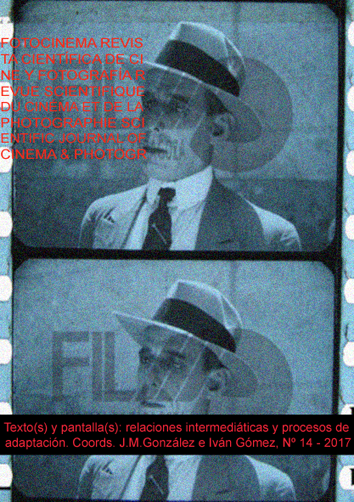El cine de Jorge Semprún. La transferencia entre guiones cinematográficos, literatura y biografía
DOI:
https://doi.org/10.24310/Fotocinema.2017.v0i14.3570Keywords:
cine, cine político, guión, literatura, memoria, política, Cinema, Political Cinema, Screenwriting, Literature, Memory, PoliticsAbstract
Jorge Semprún es una de las figuras más destacadas dentro de la cultura española y europea del siglo XX, debido a su carácter poliédrico como político, intelectual, escritor, y cineasta. Es precisamente esta última faceta, en relación con su trayectoria en los otros campos, la que menos interés ha suscitado dentro de los abundantes estudios y biografías surgidos en torno a su figura. El artículo se propone indagar en su obra cinematográfica como guionista, y también como director de un único filme documental, pero partiendo de la perspectiva de la relación directa de influencia e inspiración en múltiples direcciones entre sus creaciones para el cine, las obras de terceros autores en que ocasionalmente se basan sus libretos, y su propia creación literaria, todo ello imbuido siempre de su rica experiencia biográfica, paralela a algunos de los principales acontecimientos históricos del siglo XX, y filtrada por un elaborado estilo creativo basado en los mecanismos de la memoria, a caballo entre realidad y fabulación.
Abstract:
Jorge Semprún is one of the most outstanding figures in the Spanish and European culture of the 20th century, due to his polyhedral character as a politician, intellectual, writer, and filmmaker. It is precisely this last facet, in relation to its trajectory in the other fields, that less interest has aroused in the abundant studies and biographies that have arisen around its figure. The article intends to investigate in his cinematographic work as scriptwriter, and also as director of a single documentary film, but starting from the perspective of the direct relation of influence and inspiration in multiple directions between his creations for the cinema, the works of third authors in which his screenplays are occasionally based, and his own literary creation, always imbued with his rich biographical experience, parallel to some of the major historical events of the twentieth century, and filtered by an elaborate creative style based on the mechanisms of memory, riding between reality and fable.
Downloads
Metrics
References
Augstein, F. (2010). Lealtad y traición. Jorge Semprún y su siglo. Barcelona: Tusquets.
Céspedes, J. (2011). Cinéma et engagement. Jorge Semprun scénariste. Condé-sur-Noireau: CinémAction-Éditions Charles Corlet.
Fox Maura, S. (2016). Ida y vuelta. La vida de Jorge Semprún. Barcelona: Debate.
Jimeno Aranda, R. (2015). Jorge Semprún, la memoria de un cineasta. Experiencia vital, literatura y principios ideológicos en Les deux mémoires (1974). En Castán, J. (Ed.). Estudios de historia y estética del cine. 50º aniversario de la Cátedra de Cine de la Universidad de Valladolid. (151-158). Valladolid: Universidad de Valladolid, Cátedra de cine de la Universidad de Valladolid.
London, A. (2000). La confesión. En el engranaje del proceso de Praga. Vitoria-Gasteiz: Ikusager Ediciones.
Nieto, F. (2014). La aventura comunista de Jorge Semprún. Exilio, clandestinidad y ruptura. Barcelona: Tusquets.
Resnais, A. (1966). La guerre est finie. Francia: Europa-Film / Sofracima.
Riambau, E. (2007). De traidores y héroes. El cine de Costa-Gavras. Guadalajara (México): Festival Internacional de Cine de Guadalajara y Universidad de Guadalajara.
Semprún, J. (1977). Autobiografía de Federico Sánchez. Barcelona: Planeta.
Semprún, J. (1983). Montand, la vida continúa. Barcelona: Planeta.
Semprún, J. (1986). Aquel domingo. Barcelona: Seix Barral.
Semprún, J. (1994). La escritura o la vida. Barcelona: Tusquets.
Semprún, J. (1998). Adiós, luz de veranos. Barcelona: Tusquets.
Semprún, J. (2011). Viviré con su nombre, morirá con el mío. Barcelona: Tusquets.
Semprún, J. (2016). Ejercicios de supervivencia. Barcelona: Tusquets.
Vallet, J. (2010). Joseph Losey. Madrid: Cátedra
Downloads
Published
How to Cite
Issue
Section
License
All contents published in Fotocinema Revista científica de cine y fotografía are protected under the Creative Commons Attribution-NonCommercial-ShareAlike 4.0 International (CC BY-NC-SA 4.0) license. All about this license is available in the following link: <http://creativecommons.org/licenses/by-nc-sa/4.0>
Users can copy, use, redistribute, share and exhibit publicly as long as:
- The original source and authorship of the material are cited (Journal, Publisher and URL of the work).
- It is not used for comercial purposes.
- The existence of the license and its especifications are mentioned.
There are two sets of authors’ rights: moral and property rights. Moral rights are perpetual prerogatives, unrenounceable, not-transferable, unalienable, imprescriptible and inembargable. According to authors’ rights legislation, Fotocinema. Revista científica de cine y fotografía recognizes and respects authors moral rights, as well as the ownership of property rights, which will be transferred to University of Malaga in open access. The property rights are referred to the benefits that are gained by the use or the dissemination of works. Fotocinema. Revista científica de cine y fotografía is published in an open access form and it is exclusively licenced by any means for doing or authorising distribution, dissemination, reproduction, , adaptation, translation or arrangement of works.
Authors are responsable for obtaining the necessary permission to use copyrighted images.













13.png)



